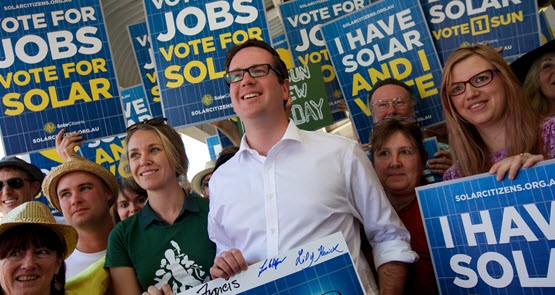Labor candidate for Canning Matt Keogh outside his campaign office
After weeks of promotion as the decisive test of Tony Abbott’s hold on the prime ministership, the campaign for tomorrow’s Canning byelection lost much of its sting on Monday when Liberal leadership plotters decided they couldn’t wait that long.
That may well be for the best, because the confounding array of factors at work meant the byelection had limited value as a litmus test, even before it was made to carry a further burden as a referendum on yet another prime ministerial leadership coup.
The confused picture in Canning is illustrated by the fact that Liberal and Labor have found equally convincing lines to workshop as they prepare to spin the result.
Liberals will be spending Sunday talking up the personal vote that accrued to the late member, Don Randall, and the inevitability of a swing back to Labor in his absence. A 6% difference between local results at the federal and state elections in 2013 shows this to be more than just idle flattery of Randall’s memory.
For Labor’s part, it has been advancing the view that a byelection is a tough gig for an opposition when brought about by the death of a sitting member, rather than the more usual mid-term departure by a political has-been in search of greener career pastures.
Labor has been particularly keen to advertise the fact that a seat hasn’t changed hands under such circumstances since 1966 — although there have, in fact, been precious few competitive federal byelections caused by deaths since that time.
Even so, the uncontroversial origin of the byelection no doubt explains why the heavy-duty double-digit swings that struck the state governments of Barry O’Farrell and Campbell Newman have never appeared in prospect, despite the federal government’s consistently dismal standing in the polls.
Further complicating the task of interpreting the outcome in Canning is the electorate’s poor fit for its assumed role as a representative slice of modern Australia.
Most obviously, the electorate is located on the wrong side of the country, in a state that has very often moved to its own electoral rhythms — notably in 2007, when Labor managed to lose two Perth seats in the context of an election that swept the Howard government from office.
The 2007 result was symptomatic of a Liberal supremacy that carried through to the federal and state elections of 2013, fuelled in large part by a mining boom that fattened wallets and encouraged feelings of affinity with the conservative side of politics.
That bubble has since burst, and with it has disappeared the 1.2% gap between the national and state unemployment rates that existed at the time the Abbott government came to power. As such, the state would seem to be well primed for a correction after the Liberals’ historic high-water mark in 2013.
Conversely, Canning’s demographic peculiarities — a lack of ethnic diversity and generally low levels of educational attainment — made for a receptive audience to Tony Abbott’s national security pitch, as well as for Liberal candidate Andrew Hastie, who seemed to have been purposefully chosen to personify it.
Further complicating byelection analysis is Canning’s position on Perth’s southern fringe, where it gathers together disparate areas with no clear community of interest.
About three-quarters of the voters are in the two dominant population centres of Armadale and Mandurah, which are separated by 60 kilometres of semi-rural and dairy farming territory. Armadale is notably unfashionable, a point well illustrated by the assortment of bogan and meth lab jokes that can be found on an “Armadale memes” Facebook page.
The suburb accordingly had little appeal to the cashed-up fly-in fly-out workforce during the glory days of the mining boom. However, that hasn’t stopped it from being hit particularly hard by the downturn, which has pushed the local unemployment rate to the cusp of double figures — 2.4% higher than where it was two years ago. Its assortment of social problems are attended by a high crime rate, which both sides have sought to turn to their advantage by announcing strategies to deal with the “ice epidemic”.
Much of this is contrast with Mandurah, which is distinguished by a large retiree population and a slower pace of life. The strength of support for Don Randall at this end of Canning was considerably less of a mystery than it was in Armadale, which narrowly broke in Randall’s favour in 2013 despite furnishing Labor with one of its safest seats in the state parliament.
From this confusing mix of elements will emerge the magic number of a two-party preferred swing, which polling indicated was set to test the limits of Tony Abbott’s comfort zone by coming in at around 10%.
A poll conducted by ReachTEL for the Seven Network as the leadership drama unfolded on Monday night suggested a Malcolm Turnbull prime ministership would cut that in half.
If that is borne out tomorrow, the swing will be small enough to bring to mind Labor’s portentous failure in the Melbourne seat of Aston in July 2001, which proved to be a signpost to John Howard’s re-election later that year.
That such a result may, objectively speaking, mean very little is unlikely to offer much comfort to Bill Shorten, who is a captive player in a game that allows for little distinction between perception and reality.









Poor old Bill: at risk of being skewered in a by-election which, in more “normal” times, may not have even featured an ALP candidate.